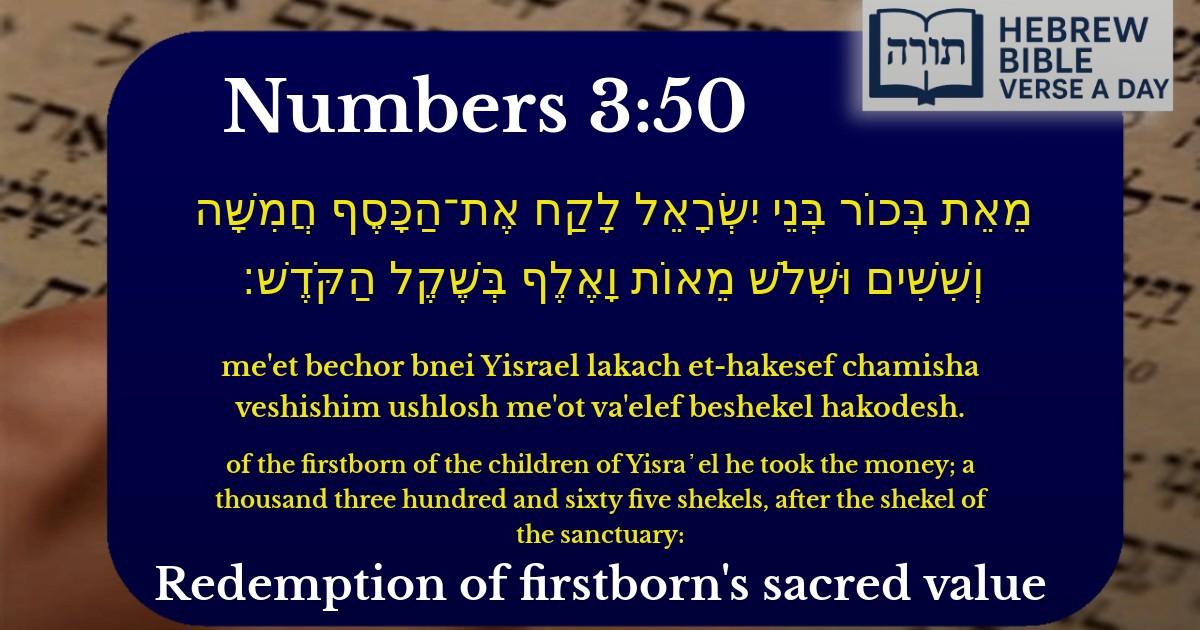Frequently Asked Questions
Q: What does Numbers 3:50 mean?
A: Numbers 3:50 describes the redemption money collected from the firstborn of Israel who outnumbered the Levites. Since the Levites were chosen to serve in the Mishkan (Tabernacle) in place of the firstborn, a redemption fee of five shekels per firstborn (as commanded in Numbers 3:47) was paid for the excess firstborn. The total collected was 1,365 shekels of silver, using the sacred shekel weight.
Q: Why was silver used for redeeming the firstborn?
A: Silver was used because the Torah (Numbers 3:47) specifically commands that the redemption price for each firstborn is five shekels of silver, weighed according to the 'shekel of the sanctuary.' This was a fixed value to maintain fairness and holiness in the redemption process, as explained by Rashi and other commentators.
Q: What is the significance of the 'shekel of the sanctuary'?
A: The 'shekel of the sanctuary' (שֶׁקֶל הַקֹּדֶשׁ) was a standardized holy measure used for all contributions to the Mishkan and Temple. Rashi explains that this ensured uniformity in weights and prevented discrepancies. It symbolizes that all aspects of divine service—even monetary calculations—must be conducted with sanctity and precision.
Q: How does the concept of redeeming the firstborn apply today?
A: Today, the mitzvah of Pidyon HaBen (redemption of the firstborn son) still applies to Jewish families where the father and mother are not from the tribe of Levi or Kohanim. A Kohen performs the ceremony, and the father redeems his firstborn son with five silver coins (or equivalent value), as derived from this verse and discussed in the Talmud (Bechorot 49a).
Q: Why were the Levites chosen instead of the firstborn?
A: Originally, the firstborn were sanctified for service after being spared in Egypt (Exodus 13:2). However, after the sin of the Golden Calf, the Levites—who did not participate—were chosen instead (Numbers 3:12-13, 8:16-18). This teaches the importance of loyalty to Hashem, as emphasized by Rashi and the Midrash.


Context in the Torah
The verse (Bamidbar 3:50) describes the redemption of the firstborn of Israel after the Exodus, where silver shekels were collected as a substitute for their service. This was necessary because originally, the firstborn were designated for Divine service, but after the sin of the Golden Calf, the Levites took their place (Rashi, Bamidbar 3:45). The silver shekels were given to the Kohanim and Levites as compensation.
The Calculation of the Shekels
The verse specifies the amount as 1,365 shekels of silver, weighed according to the "shekel of the sanctuary" (שֶׁקֶל הַקֹּדֶשׁ). The shekel hakodesh was a standardized weight used for sacred purposes, equivalent to 20 gerah (Shemot 30:13). Rashi explains that this sum was calculated based on the excess number of firstborn Israelites over the number of Levites available to replace them (Bamidbar 3:39-43).
Significance of the Number 1,365
The Midrash Rabbah (Bamidbar 4:8) notes that the number 1,365 corresponds to the numerical value (gematria) of the phrase "כל נדרי" ("Kol Nidrei"), hinting at the sanctity and binding nature of vows related to sacred matters. Additionally, the Baal HaTurim observes that this number is one more than the 1,364 firstborn Levites, emphasizing that even a single Jewish soul is precious before Hashem.
The Role of the Sanctuary Shekel